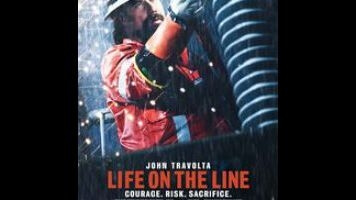On a broad scale, the producers of mostly VOD releases like Life On The Line don’t have much to answer for, because their movies don’t often add up to much beyond a way for aging and/or cash-strapped movie stars to extend their leading-man (or lady, but usually man) years a little longer. But these indulgences, while essentially harmless, do their part to chip away at better movies. An older star like John Travolta (or Bruce Willis, or Wesley Snipes, or any number of others) should be well into the character actor portion of his career about now, and Travolta briefly seemed to be heading in that direction back in 2012 when he took a supporting role in Oliver Stone’s Savages. It hasn’t really taken, in part because he’s been lured into a series of thrillers seemingly designed to simulate his glory years from inside a Redbox. Movies like Life On The Line, which is about the salt-of-the-earth linemen who make emergency repairs to our electrical grid, fancy themselves meat-and-potatoes dramatic thrillers that big studios don’t often make anymore. Unfortunately, they’re more like gristle mixed in with a couple of burnt french fries.
It becomes clear early in Life On The Line that Travolta had to take the part of Beau, a grizzled “old school” veteran lineman, because the participation of Bruce Willis would have made it even more obvious that the story’s a discount-store knockoff of Armageddon. Beau is a father figure to his niece, Bailey (Kate Bosworth), whose lineman father and worrying mother were both killed during a storm years earlier. Bailey has eyes for Duncan (Devon Sawa), who has just entered the lineman game, much to the chagrin of Beau, who (to his credit) wants better for her than the life of a lineman’s perpetually worried wife. Additional (and sometimes quite ugly!) soap opera complications surround the characters as they kill time waiting for a climactic storm to roll in around the 65-minute mark and place everyone in peril.
The characters don’t really know the storm is coming, and the movie has little patience for atmospheric foreboding. But it does include a helpful running countdown on screen (“six days until the storm,” etc.), which offers a vague sense of when characters might start getting killed, and also how much time has inexplicably passed between some of the scenes. Life On The Line takes a long time to attempt delivery of any kind of goods, yet also seems impatient with itself to just end already.
The movie’s reason for being, beyond employment outreach for stars who should know better, is to shine a light on linemen, who do an extraordinarily dangerous job without the same level of public awareness as, say, firefighters. But Life On The Line’s level of detail ends with that implied comparison; it wants only to add linemen to a list of potentially fallen heroes, while showing minimal interest in non-soapy details of the work or lives.
The nothingness starts to show early on; Bosworth opens many of her scenes appearing to concentrate very, very hard on staring off into the distance. She may be calculating and recalculating her character’s age, which based on Beau’s talk of her going off to college may be significantly younger than her own. Travolta is also probably playing a decade or so younger than his real-life number, but it’s harder to tell because of what may have been a major enticement for him taking this role in the first place: the big, unruly beard he gets to sport for the whole movie. Based on a brief flashback, Beau is a former motorcycle-riding drifter who came home to make good as a lineman, but kept the biker beard.
Those occasional character flashbacks are delivered with the elegance of a TV commercial cutaway, and one character’s life-before-his-eyes flash is suspiciously truncated, consisting mainly of footage from earlier in the movie. Much of Life is dedicated to this kind of goosing up of uninspired footage; the opening credits roll over menacing shots of power lines designed to make them look like a fearsome, unknowable enemy.
The director, David Hackl, made Saw V (and served as production designer for Saws II through IV), and as unpromising as that credit is, it must be said that Life On The Line is significantly less entertaining than the third-worst Saw movie. Why would Travolta, Bosworth, and a poorly used Sharon Stone rather star in this than take smaller parts in movies that are at least middling? In a lengthy (and poorly written) end-credits spiel, the movie does its best to convince its audience (and itself) that it’s performing a kind of advocacy, pointing viewers to a memorial site. But it does this by sentimentalizing and lionizing Travolta’s character whenever possible. The slumming stars actually make the situation worse for everyone; Life On The Line plays like an ego trip without any accompanying fun.









































